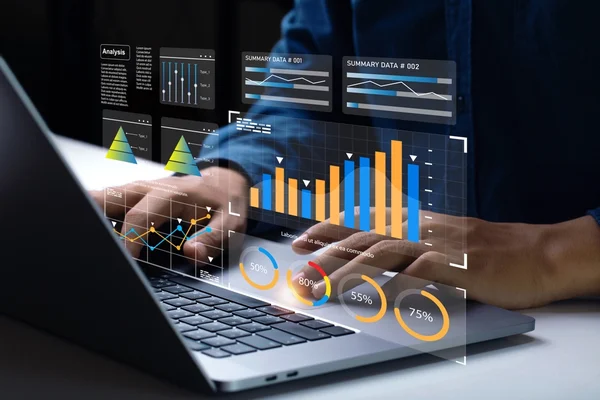HR Technology to Power Your Team
How to Assess Your Platforms, Workflows, and ROI
What Is HR Technology?
HR technology and platforms have revolutionized the way HR teams operate, enhancing efficiency and employee experiences. In today's fast-evolving landscape, regular, in-depth assessment of your tech stack is vital to stay ahead of trends, optimize resources, and ensure that your HR processes align with the ever-changing needs of your organization and workforce. Let’s explore a few key questions and assess your tech stack!
Reach Out
HR Technology Key Terms and Frequently Asked Questions
What is HR Technology and Why is it Important for Modern HR Practices?
HR technology, often referred to as HR tech, encompasses software and digital tools designed to streamline and enhance various HR functions. It's crucial for modern HR practices because it automates processes, improves data management, enhances employee experiences, and enables data-driven decision-making, ultimately helping HR professionals become more strategic and efficient.
What are the Key Components and Functionality of HR Software Systems?
HR software systems typically include components for employee management, payroll and benefits administration, talent acquisition, performance management, learning and development, and analytics. These systems offer functionalities such as employee records management, recruitment and applicant tracking, performance reviews, training tracking, and reporting.
How do I Assess the Specific HR Technology Needs of My Organization?
Assess your organization's HR technology needs by conducting a thorough analysis of current HR processes, identifying pain points, and defining goals. Engage with HR stakeholders to gather input and prioritize functionalities based on your organization's unique requirements and strategic objectives.
What are the Advantages of Implementing HR Technology in Terms of Efficiency, Cost Savings, and Compliance?
HR technology enhances efficiency by automating manual tasks, reduces administrative errors, and streamlines workflows. It can lead to cost savings through improved resource allocation and compliance by ensuring accurate and consistent HR practices and data management.
What are the Latest Trends and Innovations in HR Technology, and How Can They Benefit My Organization?
Recent trends include AI and machine learning, chatbots for HR support, remote work solutions, predictive analytics, and tools for employee well-being. These innovations can enhance employee experiences, increase productivity, and provide insights for strategic decision-making.
What are the Main Types of HR Software Available (E.G., HRIS, ATS, LMS), and Which One(s) Should I Consider for My Organization?
Common HR software types include Human Resource Information Systems (HRIS), Applicant Tracking Systems (ATS), Learning Management Systems (LMS), and Performance Management Software. The choice depends on your organization's specific needs and priorities.
How can HR Technology Improve Talent Acquisition and Recruitment Processes, From Sourcing to Onboarding?
HR technology streamlines the recruitment process by automating job postings, resume screening, interview scheduling, and onboarding tasks. It enhances candidate experiences, reduces time-to-fill positions, and improves the quality of hires.
What are the Features and Benefits of Employee Self-Service Portals within HR Technology Platforms?
Employee self-service portals empower employees to access and update their HR information, request time off, view pay stubs, and enroll in benefits. This reduces HR's administrative workload, enhances data accuracy, and increases employee engagement.
How can HR Technology Help with Performance Management, Feedback, and Development?
HR technology facilitates continuous feedback, goal setting, performance appraisals, and development planning. It enables real-time performance tracking, identifies skill gaps, and supports employee growth.
What are the Data Security and Privacy Considerations when Implementing HR Technology Solutions?
Data security, encryption, compliance with data protection regulations (e.g., GDPR, CCPA), and robust access controls are essential considerations to safeguard sensitive HR data.
What is the Role of AI and Machine Learning in HR Technology, and How Can They Enhance HR Decision-Making Processes?
AI and machine learning can automate candidate matching, predict employee turnover, provide personalized learning recommendations, and offer insights for strategic HR planning.
What are the Best Practices for Selecting the Right HR Technology Vendor or Platform for My Organization?
Best practices include defining clear objectives, conducting thorough vendor research, seeking references, assessing scalability, ensuring data integration capabilities, and conducting pilot tests.
How can I Measure the ROI of HR Technology Implementation?
Measure ROI by tracking key metrics like reduced time spent on administrative tasks, cost savings, improved compliance, increased employee engagement, and enhanced recruitment efficiency.
What Resources, Training, and Support are Typically Provided by HR Technology Vendors to Assist with Implementation and Ongoing Use?
Vendors often offer implementation support, training programs, user documentation, and customer support to assist HR professionals in adopting and maximizing the use of their technology solutions.
How Can I Measure the ROI of HR Technology Implementation?
Measuring the Return on Investment (ROI) of HR technology implementation is essential for demonstrating the value of your technology investments and ensuring that they align with your organization's strategic objectives. Here are key steps to effectively measure HR technology ROI:
- Define Clear Objectives: Begin by defining specific and measurable objectives for your HR technology implementation. These objectives should align with your organization's goals, whether it's improving recruitment efficiency, reducing employee turnover, or enhancing HR process automation.
- Baseline Data: Before implementing the technology, establish a baseline of relevant metrics that represent the state of HR processes or issues you aim to address. These metrics could include time-to-fill vacancies, turnover rates, cost per hire, or employee engagement scores.
- Post-Implementation Data: After the HR technology has been in use for a significant period, gather data to assess its impact. Compare post-implementation metrics with the baseline data to identify changes and improvements directly attributed to the technology.
- Quantify Cost Savings: Calculate cost savings resulting from HR technology implementation. This can include reduced administrative overhead, lower recruitment advertising costs, decreased turnover-related expenses, or improved compliance, all of which contribute to overall ROI.
- Productivity Gains: Evaluate productivity gains achieved through automation and streamlined processes. Measure how much time HR staff saved on routine tasks, which can then be allocated to more strategic activities.
- Improved Decision-Making: Assess the impact of HR technology on decision-making processes. Determine if access to data analytics and reporting tools has led to more informed HR decisions, better workforce planning, and talent optimization.
- Employee Experience: Consider the impact on the employee experience. Improved onboarding, self-service capabilities, and enhanced communication tools can positively influence employee satisfaction and engagement, indirectly contributing to ROI.
- Qualitative Data: Don't overlook qualitative data. Gather feedback from HR staff, managers, and employees on their experiences with the technology, including usability, efficiency, and overall satisfaction.
- Calculate ROI: Calculate the ROI by comparing the benefits gained (cost savings, productivity gains, improved processes) to the total costs associated with acquiring, implementing, and maintaining the HR technology.
- Continuous Monitoring: ROI measurement is an ongoing process. Continue to monitor and assess the technology's impact over time, making adjustments and improvements as needed.
Measuring HR technology ROI provides tangible evidence of the value it brings to your organization. It helps secure support for technology initiatives, justifies investments, and guides future decisions to optimize HR processes and achieve strategic HR objectives.
What Questions Should an HR Professional Ask to Assess Their HR Technology and Platforms?
Navigating the world of HR technology is a complex but rewarding journey that can transform HR practices, improve employee experiences, and drive organizational success. Careful consideration of these questions will help HR professionals make informed decisions and harness the full potential of HR technology.
Assessing your HR technology stack to improve ROI, increase efficiency, and streamline workflows on busy teams involves asking in-depth questions that address specific pain points and objectives. Here are some questions an HR professional might consider:
ROI and Cost Efficiency
- What is the total cost of ownership (TCO) for our current HR technology stack, including licensing, maintenance, training, and support fees? Are there any hidden costs we need to be aware of?
- How has our current HR technology contributed to cost savings or increased efficiency in HR processes, such as recruitment, onboarding, or benefits administration?
- Can we identify specific metrics or key performance indicators (KPIs) that demonstrate the ROI of our HR technology investments, such as reduced time-to-fill for open positions or decreased manual data entry?
Bandwidth and Efficiency
- Where are the bottlenecks or time-consuming tasks within our HR processes, and how can our HR technology stack alleviate these challenges?
- Are there opportunities to automate routine HR tasks, such as data entry, compliance reporting, or employee record updates, to free up HR team members for more strategic work?
- Does our current HR technology stack integrate seamlessly with other systems and tools we use across the organization, or are there manual data transfers and duplicate data entry that can be eliminated?
Workflow Improvement
- How well does our HR technology facilitate collaboration and communication within our HR team and with other departments? Are there tools or features that can enhance cross-functional workflows?
- Are there any critical HR processes that are prone to errors or inefficiencies, and can our technology stack provide safeguards or automation to improve accuracy and consistency?
- Can we identify opportunities to customize or configure our HR technology to align with our specific workflow requirements, rather than adapting our processes to fit the technology?
User Experience and Adoption
- What feedback have HR team members provided regarding the usability and effectiveness of our current HR technology tools? Are there pain points or usability issues that need to be addressed?
- Have we provided adequate training and support to ensure that HR team members are proficient in using our HR technology stack to its full potential?
- Is there a process for collecting and acting upon user feedback to continuously enhance our HR technology's user experience and functionality?
Security and Compliance
- How does our HR technology stack address data security and compliance requirements, including data encryption, access controls, and compliance with relevant regulations (e.g., GDPR, HIPAA)?
- Are there any data privacy or security risks associated with our current technology stack, and how can we mitigate them?
- Does our technology enable us to maintain accurate and up-to-date records for compliance reporting, audits, and employee data protection?
Assessing your HR technology stack with these in-depth questions can help HR professionals identify areas for improvement, optimize ROI, and enhance the efficiency of their workflows. It also ensures that technology investments align with the strategic goals of the HR department and the organization as a whole.
Need Help Recruiting?
Get local and global recruiting services and start scaling up your teams today!
Expert Insights: How Do I Assess the Specific HR Technology Needs of My Organization?
Assessing the specific HR technology needs of your organization is a crucial step in aligning your HR practices with the strategic goals and operational requirements of the company. To undertake this assessment effectively, consider the following key steps:
- Comprehensive Process Analysis: Begin by conducting a thorough analysis of your existing HR processes, workflows, and pain points. Identify the tasks that are time-consuming, prone to errors, or require manual data entry. This will help you pinpoint areas where technology can provide the most significant benefits.
- Stakeholder Engagement: Engage with HR team members, department heads, and other key stakeholders to gather input. Understand their challenges, needs, and the specific functionalities they require from an HR technology solution. Their insights are invaluable for tailoring technology to their roles.
- Strategic Alignment: Align your assessment with the organization's strategic objectives. Identify how HR technology can support these goals, such as improving talent acquisition, enhancing employee engagement, or ensuring compliance with regulatory requirements.
- Scalability and Growth: Consider your organization's growth trajectory and scalability needs. Ensure that the chosen HR technology can accommodate increasing data volumes, employee numbers, and evolving HR processes.
- Data Integration: Evaluate the current systems and tools used across the organization. Determine how HR technology can integrate seamlessly with these systems to streamline data sharing, reduce redundancy, and improve data accuracy.
- User-Friendly Interfaces: Assess the usability and accessibility of potential HR technology solutions. User-friendly interfaces are essential for user adoption and minimizing the learning curve for your HR team.
- Vendor Research: Research HR technology vendors and solutions available in the market. Consider factors like reputation, customer reviews, pricing, support, and scalability. Request demos and references to get a firsthand understanding of how a solution fits your needs.
- Customization and Flexibility: Determine the level of customization and flexibility required for your HR technology. Ensure it can be tailored to your specific workflow and process requirements rather than forcing you to adapt to the technology.
- Security and Compliance: Prioritize data security and compliance. Ensure that the selected HR technology complies with data protection regulations and offers robust security features to safeguard sensitive HR data.
- Cost-Benefit Analysis: Conduct a cost-benefit analysis to evaluate the return on investment (ROI) of potential HR technology solutions. Consider both immediate and long-term costs and benefits, including efficiency gains and improved HR outcomes.
By conducting a holistic assessment that combines insights from process analysis, stakeholder input, strategic alignment, and careful vendor evaluation, you can identify the HR technology solutions that best meet the specific needs of your organization, enhancing HR efficiency and effectiveness while contributing to overall organizational success.

How Can I Measure the ROI of HR Technology Implementation?
Measuring the Return on Investment (ROI) of HR technology implementation is essential for demonstrating the value of your technology investments and ensuring that they align with your organization's strategic objectives. Here are key steps to effectively measure HR technology ROI:
- Define Clear Objectives: Begin by defining specific and measurable objectives for your HR technology implementation. These objectives should align with your organization's goals, whether it's improving recruitment efficiency, reducing employee turnover, or enhancing HR process automation.
- Baseline Data: Before implementing the technology, establish a baseline of relevant metrics that represent the state of HR processes or issues you aim to address. These metrics could include time-to-fill vacancies, turnover rates, cost per hire, or employee engagement scores.
- Post-Implementation Data: After the HR technology has been in use for a significant period, gather data to assess its impact. Compare post-implementation metrics with the baseline data to identify changes and improvements directly attributed to the technology.
- Quantify Cost Savings: Calculate cost savings resulting from HR technology implementation. This can include reduced administrative overhead, lower recruitment advertising costs, decreased turnover-related expenses, or improved compliance, all of which contribute to overall ROI.
- Productivity Gains: Evaluate productivity gains achieved through automation and streamlined processes. Measure how much time HR staff saved on routine tasks, which can then be allocated to more strategic activities.
- Improved Decision-Making: Assess the impact of HR technology on decision-making processes. Determine if access to data analytics and reporting tools has led to more informed HR decisions, better workforce planning, and talent optimization.
- Employee Experience: Consider the impact on the employee experience. Improved onboarding, self-service capabilities, and enhanced communication tools can positively influence employee satisfaction and engagement, indirectly contributing to ROI.
- Qualitative Data: Don't overlook qualitative data. Gather feedback from HR staff, managers, and employees on their experiences with the technology, including usability, efficiency, and overall satisfaction.
- Calculate ROI: Calculate the ROI by comparing the benefits gained (cost savings, productivity gains, improved processes) to the total costs associated with acquiring, implementing, and maintaining the HR technology.
- Continuous Monitoring: ROI measurement is an ongoing process. Continue to monitor and assess the technology's impact over time, making adjustments and improvements as needed.
Measuring HR technology ROI provides tangible evidence of the value it brings to your organization. It helps secure support for technology initiatives, justifies investments, and guides future decisions to optimize HR processes and achieve strategic HR objectives.
What Questions Should an HR Professional Ask to Assess Their HR Technology and Platforms?
Navigating the world of HR technology is a complex but rewarding journey that can transform HR practices, improve employee experiences, and drive organizational success. Careful consideration of these questions will help HR professionals make informed decisions and harness the full potential of HR technology.
Assessing your HR technology stack to improve ROI, increase efficiency, and streamline workflows on busy teams involves asking in-depth questions that address specific pain points and objectives. Here are some questions an HR professional might consider:

ROI and Cost Efficiency
- What is the total cost of ownership (TCO) for our current HR technology stack, including licensing, maintenance, training, and support fees? Are there any hidden costs we need to be aware of?
- How has our current HR technology contributed to cost savings or increased efficiency in HR processes, such as recruitment, onboarding, or benefits administration?
- Can we identify specific metrics or key performance indicators (KPIs) that demonstrate the ROI of our HR technology investments, such as reduced time-to-fill for open positions or decreased manual data entry?
Bandwidth and Efficiency
- Where are the bottlenecks or time-consuming tasks within our HR processes, and how can our HR technology stack alleviate these challenges?
- Are there opportunities to automate routine HR tasks, such as data entry, compliance reporting, or employee record updates, to free up HR team members for more strategic work?
- Does our current HR technology stack integrate seamlessly with other systems and tools we use across the organization, or are there manual data transfers and duplicate data entry that can be eliminated?
Workflow Improvement
- How well does our HR technology facilitate collaboration and communication within our HR team and with other departments? Are there tools or features that can enhance cross-functional workflows?
- Are there any critical HR processes that are prone to errors or inefficiencies, and can our technology stack provide safeguards or automation to improve accuracy and consistency?
- Can we identify opportunities to customize or configure our HR technology to align with our specific workflow requirements, rather than adapting our processes to fit the technology?
User Experience and Adoption
- What feedback have HR team members provided regarding the usability and effectiveness of our current HR technology tools? Are there pain points or usability issues that need to be addressed?
- Have we provided adequate training and support to ensure that HR team members are proficient in using our HR technology stack to its full potential?
- Is there a process for collecting and acting upon user feedback to continuously enhance our HR technology's user experience and functionality?
Security and Compliance
- How does our HR technology stack address data security and compliance requirements, including data encryption, access controls, and compliance with relevant regulations (e.g., GDPR, HIPAA)?
- Are there any data privacy or security risks associated with our current technology stack, and how can we mitigate them?
- Does our technology enable us to maintain accurate and up-to-date records for compliance reporting, audits, and employee data protection?
Assessing your HR technology stack with these in-depth questions can help HR professionals identify areas for improvement, optimize ROI, and enhance the efficiency of their workflows. It also ensures that technology investments align with the strategic goals of the HR department and the organization as a whole.
